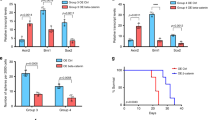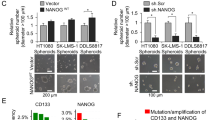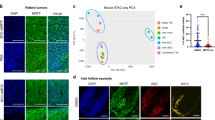Abstract
The SMOOTHENED inhibitor vismodegib is FDA approved for advanced basal cell carcinoma (BCC), and shows promise in clinical trials for SONIC HEDGEHOG (SHH)-subgroup medulloblastoma (MB) patients. Clinical experience with BCC patients shows that continuous exposure to vismodegib is necessary to prevent tumor recurrence, suggesting the existence of a vismodegib-resistant reservoir of tumor-propagating cells. We isolated such tumor-propagating cells from a mouse model of SHH-subgroup MB and grew them as sphere cultures. These cultures were enriched for the MB progenitor marker SOX2 and formed tumors in vivo. Moreover, while their ability to self-renew was resistant to SHH inhibitors, as has been previously suggested, this self-renewal was instead WNT-dependent. We show here that loss of Trp53 activates canonical WNT signaling in these SOX2-enriched cultures. Importantly, a small molecule WNT inhibitor was able to reduce the propagation and growth of SHH-subgroup MB in vivo, in an on-target manner, leading to increased survival. Our results imply that the tumor-propagating cells driving the growth of bulk SHH-dependent MB are themselves WNT dependent. Further, our data suggest combination therapy with WNT and SHH inhibitors as a therapeutic strategy in patients with SHH-subgroup MB, in order to decrease the tumor recurrence commonly observed in patients treated with vismodegib.
This is a preview of subscription content, access via your institution
Access options
Subscribe to this journal
Receive 50 print issues and online access
$259.00 per year
only $5.18 per issue
Buy this article
- Purchase on Springer Link
- Instant access to full article PDF
Prices may be subject to local taxes which are calculated during checkout





Similar content being viewed by others
References
Louis DN, Ohgaki H, Wiestler OD, Cavenee WK, Burger PC, Jouvet A et al. The 2007 WHO classification of tumours of the central nervous system. Acta Neuropathol 2007; 114: 97–109.
Crawford JR, MacDonald TJ, Packer RJ . Medulloblastoma in childhood: new biological advances. Lancet Neurol 2007; 6: 1073–1085.
Gibson P, Tong Y, Robinson G, Thompson MC, Currle DS, Eden C et al. Subtypes of medulloblastoma have distinct developmental origins. Nature 2010; 468: 1095–1099.
Northcott Pa, Dubuc AM, Pfister S, Taylor MD . Molecular subgroups of medulloblastoma. Expert Rev Neurother 2012; 12: 871–884.
Remke M, Ramaswamy V, Taylor MD . Medulloblastoma molecular dissection: the way toward targeted therapy. Curr Opin Oncol 2013; 25: 674–681.
Olson JM . Therapeutic opportunities for medulloblastoma come of age. Cancer Cell 2014; 25: 267–269.
Atwood SX, Whitson RJ, Oro AE . Advanced treatment for basal cell carcinomas. Cold Spring Harb Perspect Med 2014; 4: a013581.
Johnson RL, Rothman aL, Xie J, Goodrich LV, Bare JW, Bonifas JM et al. Human homolog of patched, a candidate gene for the basal cell nevus syndrome. Science 1996; 272: 1668–1671.
Aszterbaum M, Rothman a, Johnson RL, Fisher M, Xie J, Bonifas JM et al. Identification of mutations in the human PATCHED gene in sporadic basal cell carcinomas and in patients with the basal cell nevus syndrome. J Invest Dermatol 1998; 110: 885–888.
Ng JMY, Curran T . The Hedgehog’s tale: developing strategies for targeting cancer. Nat Rev Cancer 2011; 11: 493–501.
Rudin CM, Hann CL, Laterra J, Yauch RL, Callahan Ca, Fu L et al. Treatment of medulloblastoma with hedgehog pathway inhibitor GDC-0449. N Engl J Med 2009; 361: 1173–1178.
LoRusso PM, Rudin CM, Reddy JC, Tibes R, Weiss GJ, Borad MJ et al. Phase I trial of hedgehog pathway inhibitor vismodegib (GDC-0449) in patients with refractory, locally advanced or metastatic solid tumors. Clin Cancer Res 2011; 17: 2502–2511.
Robinson GW, Orr BA, Wu G, Gururangan S, Lin T, Qaddoumi I et al. Vismodegib exerts targeted efficacy against recurrent sonic hedgehog-subgroup medulloblastoma: results from phase II Pediatric Brain Tumor Consortium Studies PBTC-025B and PBTC-032. J Clin Oncol 2015; 33: 2646–2654.
Heppner GH . Tumor heterogeneity. Cancer Res 1984; 44: 2259–2265.
Marusyk A, Polyak K . Tumor heterogeneity: causes and consequences. Biochim Biophys Acta 2010; 1805: 105–117.
Boman BM, Wicha MS . Cancer stem cells: a step toward the cure. J Clin Oncol 2008; 26: 2795–2799.
Dean M, Fojo T, Bates S . Tumour stem cells and drug resistance. Nat Rev Cancer 2005; 5: 275–284.
Yauch RL, Dijkgraaf GJ, Alicke B, Januario T, Ahn CP, Holcomb T et al. Smoothened mutation confers resistance to a Hedgehog pathway inhibitor in medulloblastoma. Science 2009; 326: 572–574.
Wolfe CM, Green WH, Cognetta AB, Hatfield HK . Basal cell carcinoma rebound after cessation of vismodegib in a nevoid basal cell carcinoma syndrome patient. Dermatol Surg 2012; 38: 1863–1866.
Sekulic A, Migden MR, Oro AE, Dirix L, Lewis KD, Hainsworth JD et al. Efficacy and safety of vismodegib in advanced basal-cell carcinoma. N Engl J Med 2012; 366: 2171–2179.
Tang JY, Mackay-Wiggan JM, Aszterbaum M, Yauch RL, Lindgren J, Chang K et al. Inhibiting the hedgehog pathway in patients with the basal-cell nevus syndrome. N Engl J Med 2012; 366: 2180–2188.
Meani RE, Lim S-W, Chang ALS, Kelly JW . Emergence of chemoresistance in a metastatic basal cell carcinoma patient after complete response to hedgehog pathway inhibitor vismodegib (GDC-0449). Australas J Dermatol 2014; 55: 218–221.
Singh SK, Clarke ID, Terasaki M, Bonn VE, Hawkins C, Squire J et al. Identification of a cancer stem cell in human brain tumors. Cancer Res 2003; 63: 5821–5828.
Singh SK, Hawkins C, Clarke ID, Squire JA, Bayani J, Hide T et al. Identification of human brain tumour initiating cells. Nature 2004; 432: 396–401.
Ward RJ, Lee L, Graham K, Satkunendran T, Yoshikawa K, Ling E et al. Multipotent CD15+ cancer stem cells in Patched-1—deficient mouse medulloblastoma. Cancer Res 2009. 4682–4690.
Read T-A, Fogarty MP, Markant SL, McLendon RE, Wei Z, Ellison DW et al. Identification of CD15 as a marker for tumor-propagating cells in a mouse model of medulloblastoma. Cancer Cell 2009; 15: 135–147.
Corno D, Pala M, Cominelli M, Cipelletti B, Leto K, Croci L et al. Gene signatures associated with mouse postnatal hindbrain neural stem cells and medulloblastoma cancer stem cells identify novel molecular mediators and predict human medulloblastoma molecular classification. Cancer Discov 2012; 2: 554–568.
Vanner RJ, Remke M, Gallo M, Selvadurai HJ, Coutinho F, Lee L et al. Quiescent sox2(+) cells drive hierarchical growth and relapse in sonic hedgehog subgroup medulloblastoma. Cancer Cell 2014; 26: 33–47.
Ahlfeld J, Favaro R, Pagella P, Kretzschmar HA, Nicolis S, Schüller U . Sox2 requirement in sonic hedgehog-associated medulloblastoma. Cancer Res 2013; 73: 3796–3807.
Huang X, Ketova T, Litingtung Y, Chiang C . Isolation, enrichment, and maintenance of medulloblastoma stem cells. J Vis Exp 2010; 43: 2086.
Nusse R . Wnt signaling and stem cell control. Cell Res 2008; 18: 523–527.
Koch A, Waha A, Tonn JC, Sörensen N, Berthold F, Wolter M et al. Somatic mutations of WNT/wingless signaling pathway components in primitive neuroectodermal tumors. Int J Cancer 2001; 93: 445–449.
Thompson MC, Fuller C, Hogg TL, Dalton J, Finkelstein D, Lau CC et al. Genomics identifies medulloblastoma subgroups that are enriched for specific genetic alterations. J Clin Oncol 2006; 24: 1924–1931.
Kemler R . From cadherins to catenins: cytoplasmic protein interactions and regulation of cell adhesion. Trends Genet 1993; 9: 317–321.
Waterman ML . Lymphoid enhancer factor/T cell factor expression in colorectal cancer. Cancer Metastasis Rev. 2004; 23: 41–52.
Lewis SL, Khoo P-L, De Young RA, Steiner K, Wilcock C, Mukhopadhyay M et al. Dkk1 and Wnt3 interact to control head morphogenesis in the mouse. Development 2008; 135: 1791–1801.
Klein PS, Melton DA . A molecular mechanism for the effect of lithium on development. Proc Natl Acad Sci USA 1996; 93: 8455–8459.
Liu J, Pan S, Hsieh MH, Ng N, Sun F, Wang T et al. Targeting Wnt-driven cancer through the inhibition of Porcupine by LGK974. Proc Natl Acad Sci USA 2013; 110: 20224–20229.
de la Roche M, Rutherford TJ, Gupta D, Veprintsev DB, Saxty B, Freund SM et al. An intrinsically labile α-helix abutting the BCL9-binding site of β-catenin is required for its inhibition by carnosic acid. Nat Commun 2012; 3: 680.
Ewan K, Pajak B, Stubbs M, Todd H, Barbeau O, Quevedo C et al. A useful approach to identify novel small-molecule inhibitors of Wnt-dependent transcription. Cancer Res 2010; 70: 5963–5973.
Eguchi M, Nguyen C, Lee SC, Kahn M . ICG-001, a novel small molecule regulator of TCF/beta-catenin transcription. Med Chem 2005; 1: 467–472.
Gandhirajan RK, Staib PA, Minke K, Gehrke I, Plickert G, Schlösser A et al. Small molecule inhibitors of Wnt/beta-catenin/lef-1 signaling induces apoptosis in chronic lymphocytic leukemia cells in vitro and in vivo. Neoplasia 2010; 12: 326–335.
Anne SL, Govek E-E, Ayrault O, Kim JH, Zhu X, Murphy DA et al. WNT3 inhibits cerebellar granule neuron progenitor proliferation and medulloblastoma formation via MAPK activation. PLoS ONE 2013; 8: e81769.
Zinke J, Schneider FT, Harter PN, Thom S, Ziegler N, Toftgård R et al. β-Catenin-Gli1 interaction regulates proliferation and tumor growth in medulloblastoma. Mol Cancer 2015; 14: 17.
Pöschl J, Bartels M, Ohli J, Bianchi E, Kuteykin-Teplyakov K, Grammel D et al. Wnt/β-catenin signaling inhibits the Shh pathway and impairs tumor growth in Shh-dependent medulloblastoma. Acta Neuropathol 2014; 127: 605–607.
Azad N, Rasoolijazi H, Joghataie MT, Soleimani S . Neuroprotective effects of carnosic Acid in an experimental model of Alzheimer’s disease in rats. Cell J 2011; 13: 39–44.
Piccin D, Morshead CM . Wnt signaling regulates symmetry of division of neural stem cells in the adult brain and in response to injury. Stem Cells 2011; 29: 528–538.
Lange C, Mix E, Rateitschak K, Rolfs A . Wnt signal pathways and neural stem cell differentiation. Neurodegener Dis 2006; 3: 76–86.
Fan X, Eberhart CG . Medulloblastoma stem cells. J Clin Oncol 2008; 26: 2821–2827.
Zhao X, Ponomaryov T, Ornell KJ, Zhou P, Dabral SK, Pak E et al. RAS/MAPK activation drives resistance to smo inhibition, metastasis, and tumor evolution in Shh pathway-dependent tumors. Cancer Res 2015; 75: 3623–3635.
Cha YH, Kim NH, Park C, Lee I, Kim HS, Yook JI . MiRNA-34 intrinsically links p53 tumor suppressor and Wnt signaling. Cell Cycle 2012; 11: 1273–1281.
Kim NH, Kim HS, Kim N-G, Lee I, Choi H-S, Li X-Y et al. p53 and miRNA-34 are Suppressors of Canonical Wnt Signaling. Sci Signal 2011; 4: ra71.
Voorneveld PW, Kodach LL, Jacobs RJ, van Noesel CJM, Peppelenbosch MP, Korkmaz KS et al. The BMP pathway either enhances or inhibits the Wnt pathway depending on the SMAD4 and p53 status in CRC. Br J Cancer 2015; 112: 122–130.
Zhukova N, Ramaswamy V, Remke M, Pfaff E, Shih DJH, Martin DC et al. Subgroup-specific prognostic implications of TP53 mutation in medulloblastoma. J Clin Oncol 2013; 31: 2927–2935.
Tabori U, Baskin B, Shago M, Alon N, Taylor MD, Ray PN et al. Universal poor survival in children with medulloblastoma harboring somatic TP53 mutations. J Clin Oncol 2010; 28: 1345–1350.
Kool M, Jones DTW, Jäger N, Northcott PA, Pugh TJ, Hovestadt V et al. Genome sequencing of SHH medulloblastoma predicts genotype-related response to smoothened inhibition. Cancer Cell 2014; 25: 393–405.
Yang SH, Andl T, Grachtchouk V, Wang A, Liu J, Syu L-J et al. Pathological responses to oncogenic Hedgehog signaling in skin are dependent on canonical Wnt/beta3-catenin signaling. Nat Genet 2008; 40: 1130–1135.
Youssef KK, Lapouge G, Bouvrée K, Rorive S, Brohée S, Appelstein O et al. Adult interfollicular tumour-initiating cells are reprogrammed into an embryonic hair follicle progenitor-like fate during basal cell carcinoma initiation. Nat Cell Biol 2012; 14: 1282–1294.
Tam WL, Ng HH . Sox2: masterminding the root of cancer. Cancer Cell 2014; 26: 3–5.
Kenney AM, Rowitch DH . Sonic hedgehog promotes G1 cyclin expression and sustained cell cycle progression in mammalian neuronal precursors. Mol Cell Biol 2000; 20: 9055–9067.
Lee HY, Greene LA, Mason CA, Manzini MC . Isolation and culture of post-natal mouse cerebellar granule neuron progenitor cells and neurons. J Vis Exp 2009; 23: 990.
Gritti A, Parati E, Cova L, Frolichsthal P, Galli R, Wanke E et al. Multipotential stem cells from the adult mouse brain proliferate and self-renew in response to basic fibroblast growth factor. J Neurosci 1996; 16: 1091–1100.
Kennedy MWL, Kao KR . Xrel3/XrelA attenuates β-catenin-mediated transcription during mesoderm formation in Xenopus embryos. Biochem J 2011; 435: 247–257.
Rodriguez-Blanco J, Martín V, Herrera F, García-Santos G, Antolín I, Rodriguez C . Intracellular signaling pathways involved in post-mitotic dopaminergic PC12 cell death induced by 6-hydroxydopamine. J Neurochem 2008; 107: 127–140.
Fei DL, Li H, Kozul CD, Black KE, Singh S, Gosse JA et al. Activation of Hedgehog signaling by the environmental toxicant arsenic may contribute to the etiology of arsenic-induced tumors. Cancer Res 2010; 70: 1981–1988.
Goodrich LV, Milenković L, Higgins KM, Scott MP . Altered neural cell fates and medulloblastoma in mouse patched mutants. Science 1997; 277: 1109–1113.
Wetmore C, Eberhart DE, Curran T . Loss of p53 but not ARF accelerates medulloblastoma in mice heterozygous for patched. Cancer Res 2001; 61: 513–516.
Acknowledgements
We would like to thank members of the Robbins, Capobianco and Pei laboratories for providing their insights during discussions regarding this manuscript. Also, we would like to acknowledge the skilled assistance of the Sylvester Cancer Center Flow Cytometry Core. Funding: Alex Lemonade Stand Foundation M1201547 (DJR), 1R21NS096502-01 (DJR), The University of Miami Women’s Cancer Association (DJR), B*Cured 2016 (DJR), Childhood Brain Tumor Foundation (JR-B), FICYT POST10-27 (JR-B), funds from the Sylvester Cancer Center (DJR), NIH R01GM081635 (EL), and R01GM103926 (EL).
Author contributions
DJR and JR-B conceived and designed the experiments. JR-B performed the experiments. LP, CP and BL contributed to mouse work. JR-B and DJR analyzed the data. JL and EL contributed reagents/materials/analytic tools. VM, CR, DMN, PR, EL, WAW and AJC gave technical support and conceptual advice. NM provided pathological insights. DJR and JR-B wrote the paper.
Author information
Authors and Affiliations
Corresponding author
Ethics declarations
Competing interests
The authors declare no conflict of interest.
Additional information
Supplementary Information accompanies this paper on the Oncogene website
Supplementary information
Rights and permissions
About this article
Cite this article
Rodriguez-Blanco, J., Pednekar, L., Penas, C. et al. Inhibition of WNT signaling attenuates self-renewal of SHH-subgroup medulloblastoma. Oncogene 36, 6306–6314 (2017). https://doi.org/10.1038/onc.2017.232
Received:
Revised:
Accepted:
Published:
Issue Date:
DOI: https://doi.org/10.1038/onc.2017.232
This article is cited by
-
Dual Role of WISP1 in maintaining glioma stem cells and tumor-supportive macrophages in glioblastoma
Nature Communications (2020)
-
The hedgehog pathway regulates cancer stem cells in serous adenocarcinoma of the ovary
Cellular Oncology (2020)
-
Differential Expression of Genes for Ubiquitin Ligases in Medulloblastoma Subtypes
The Cerebellum (2019)



